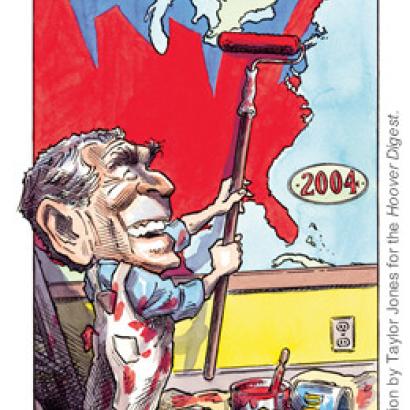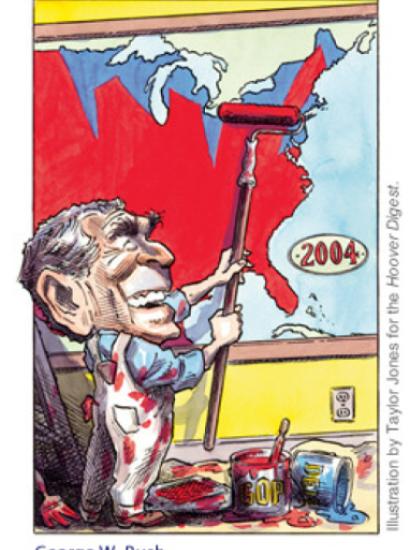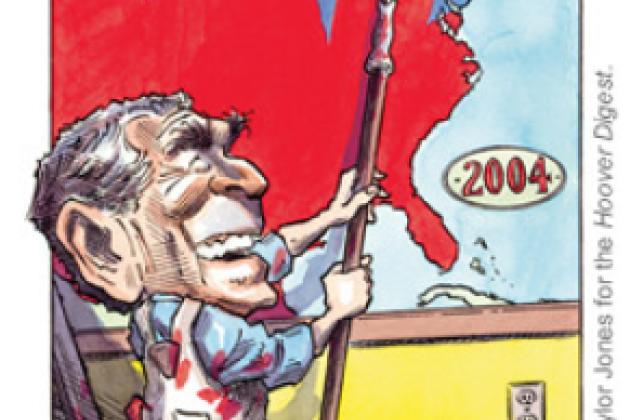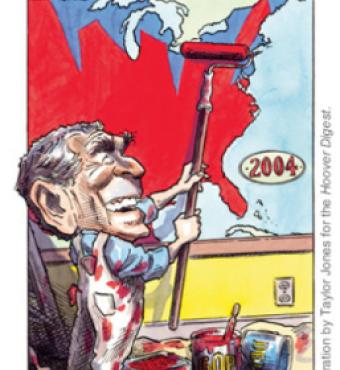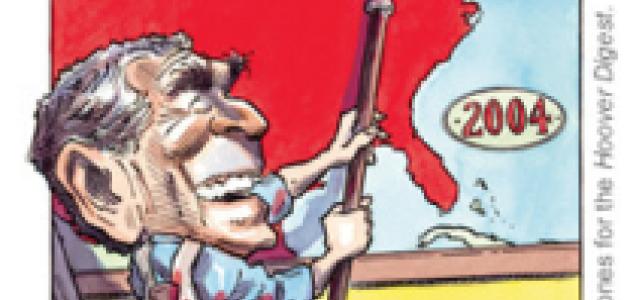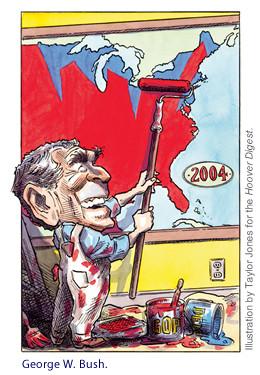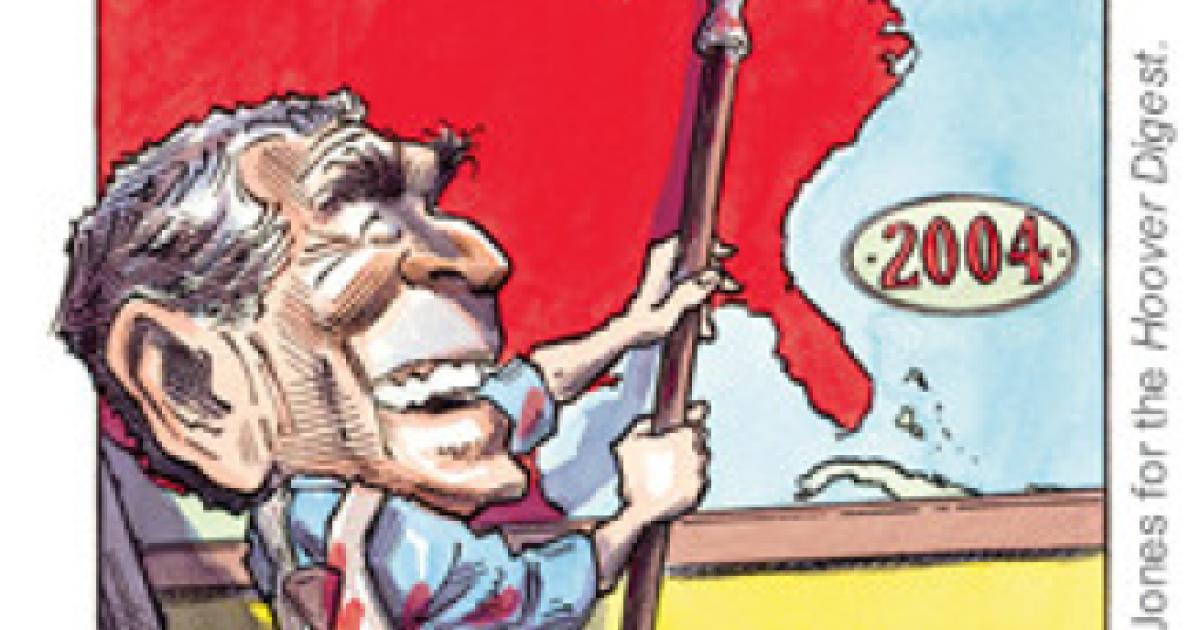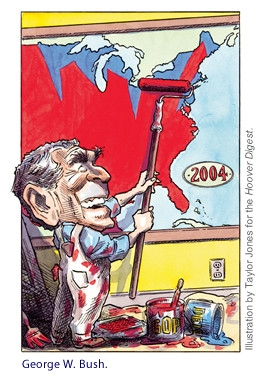
So much for a cliff-hanger next November. According to a macroeconomic model developed by Yale University, President Bush will win a second term in a rout. Taking into account inflation, GDP growth, and other economic variables, the Yalies predict that the president will garner 58.3 percent of the vote. That puts Bush in the same company as Richard Nixon (61.8 percent), Ronald Reagan (59.2 percent), and Dwight Eisenhower (57.8 percent)—Republicans each reelected in a landslide.
Will the Yale model hold up? Time will tell. But for now, it fits into one of the pre-season rituals of presidential elections. Before an actual vote is cast, there is what’s called the “media primary,” in which the political press corps adopts a pet favorite candidate (think John McCain and the “Straight Talk Express”). And before that, the “academic primary,” in which pundits try to put the current race into historic perspective. But in this election, that’s a primary without a clear front-runner.
This much we know about presidential contests of the past century. Presidents who run for reelection usually are rewarded for their effort. Since 1912, six of the nine elected incumbents won a second term. They add to their majorities, picking up an average of five more states. When they win the second time around, they win big: an average of 422 electoral votes (from a high of 525 electoral votes for Reagan in 1984 to 277 for Woodrow Wilson in 1916). And absent a third-party challenge, incumbent elected presidents are almost a sure thing; in the past century, only Herbert Hoover has lost a head-to-head race.

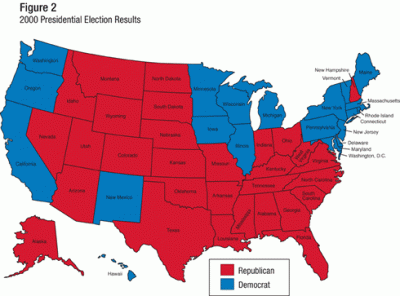
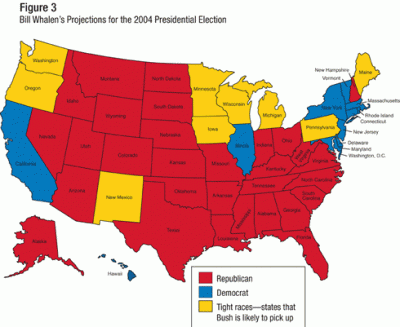
So where to place George W. Bush in this numbers game? Take the same results from the 2000 election, adjust for reapportionment, and the president would receive 278 electoral votes—the bottom rung of the re-election ladder. With an additional 2.5 percent of the vote, he picks up another 39 electoral votes. Interestingly enough, that’s five states (Iowa, Minnesota, New Mexico, Oregon, and Wisconsin), moving the Bush 2004 total to 317 electoral votes. But let’s say the president is 5 percent stronger, as a national candidate, than he was in 2000. That’s not an unreasonable assumption, given that the president is running as the leader of the free world and of a global war on terrorism, not as a governor of Texas with precious little foreign policy experience. With that extra 5 percent, Bush also gets Maine, Michigan, Pennsylvania, and Washington—53 more electoral votes. That would give the president 370 electoral votes, which is in line with the 379 electoral votes Bill Clinton received in 1996 (9 more than Clinton received in 1992).
What’s the Democrats’ rebuttal to this math? They point out that Bush lost the popular vote in 2000—the first presidential winner to do so since Benjamin Harrison in 1888. And, with either a Democratic win in Florida or Missouri, or the combination of West Virginia and New Hampshire, the White House changes hands. Add to that the president’s poll numbers that have slowly ebbed since the 9/11 terrorist attack, the spin goes, and he’s a weak incumbent ripe for a fall (never mind that both Nixon and Reagan had 49 percent approval ratings a year before their landslide reelections).
However, there’s a giant hole in this argument. While focusing on popular votes and popularity ratings, the Democrats conveniently overlook a quiet shift in voter affiliation that could lead to a larger shift in the electoral college—one that works to the Republicans’ advantage. According to the Pew
Research Center, 31 percent of registered voters call themselves Democrats and 30 percent, Republicans. That’s a 5-point gain for the GOP since 1997 and reflects a GOP surge in every major demographic group with the exception of African-Americans.
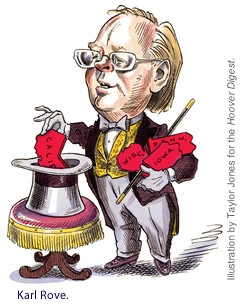
When translated to electoral votes, this spells a potential Democratic meltdown next fall. Republicans have improved their voting base in every one of the seven states that Al Gore carried with 51 percent of the vote or less in 2000. Take Iowa, for example, which Gore won by a mere 4,100 votes four years ago. In 2000, Democrats led 32 percent to 27 percent in party registration. Today, Republicans lead 34 percent to 27 percent. Gore won Wisconsin by 5,396 votes. Republicans there have added 5 points in party identification. In Michigan, which Gore won by a more comfortable 5 percent, the GOP gain is 8 percent. At the same time, Republicans have made their weakest “red” states a deeper shade of carmine. Most notably, that includes the all-important Florida, where the GOP is up 6 points.
This is not to declare that George W. Bush has a lock in November. But, absent a change in the course of this election, he’s on his way to another four years. That’s especially true if a third-party challenger does not emerge—one with the potential to pick up Republican and independent support, as did Ross Perot in 1992. On this count, the president benefits from good timing and good luck. Perot, Pat Buchanan, and Jesse Ventura all are third-party candidates past their prime. Arizona senator John McCain had his moment in the sun. Retired General Wesley Clark, a candidate not past his prime but seemingly not ready for prime time, is a Democrat, not an Independent.
To the extent that there is a non-Democratic challenge to the Bush presidency, it comes from financial third parties, rather than a single politically organized third party. The billionaire financier George Soros has donated more than $15.5 million to liberal activist groups in hopes of electing a Democrat (Soros, a Hungarian refugee, has said of the president: “When I hear Bush say, ‘You’re either with us or against us,’ it reminds me of the [Nazis].”). Also trying to engineer a Bush defeat: Cleveland insurance billionaire Peter Lewis, who’s pledged more than $12 million to such leftist groups as MoveOn.org and Americans Coming Together. The key difference here is that money will be spent on advertising campaigns to mobilize Democratic voters in some 17 swing states. That may energize the Democratic base, but, in all likelihood, it’s not as effective at taking away independent votes as would a third-party candidate. And the no-man’s-land between the two parties is where presidential contests are won and lost.
What this does suggest is that George W. Bush amounts to something of an anomaly as a presidential candidate. Surveys show him running even against an as-yet-determined Democratic opponent, which theoretically would mean the same dramatic outcome as the 2000 election. For months, White House pollsters have told the media that, at some point, Bush will trail his 2004 opponent (the analogy: even Ronald Reagan at one point trailed Walter Mondale). Meanwhile, the nation’s electoral math suggests something far less dramatic. Obviously, the key is the president’s challenger. If it’s the wrong man at the wrong time (Mondale, George McGovern, Adlai Stevenson, or Alf Landon), then Bush wins on an epic scale.
But what if the Democratic candidate proves to be more formidable? Two previous elections bear watching: Bill Clinton, in 1996, and Woodrow Wilson, in 1916. Clinton, like George W. Bush, did not receive a popular mandate in his first presidential victory (he received only 43.4 percent of the vote in a three-way split). But, four years later, he improved on that performance by nearly 6 percent. However, Clinton won the same number of states—32—both times. As for the 1916 race, it’s the rare example of a president moving both forward and backward. Thanks to a divided Republican Party in 1912, Wilson backed into office with only 41.8 percent of the vote. Four years later, in a race absent Teddy Roosevelt and the Bull Moose revolt, he improved that to 49.2 percent. However, Wilson’s electoral count fell from 435 to 277, and the number of states he won, from 40 to 21 (Wilson is the answer to another oddity: the only president twice elected without once carrying California).
Perhaps President Bush sets presidential elections on a third path this November. He is re-elected, yet not with the more than 55 percent that defines a landslide. Yet, thanks to subtle shifts in voter registration in states he narrowly lost the last time, Bush records a lopsided win where it most counts: the electoral college. Perhaps he receives as many electoral votes as Bill Clinton. Or, maybe, like father, like son: George H. W. Bush received 426 electoral votes in 1988.
Would the current President Bush accept such a victory, even if the popular vote didn’t wind up as lofty as the Yale model projects? You don’t need an Ivy League education to know how George W. Bush, Yale Class of ’68, would answer that one.








